#eukleia
Photo

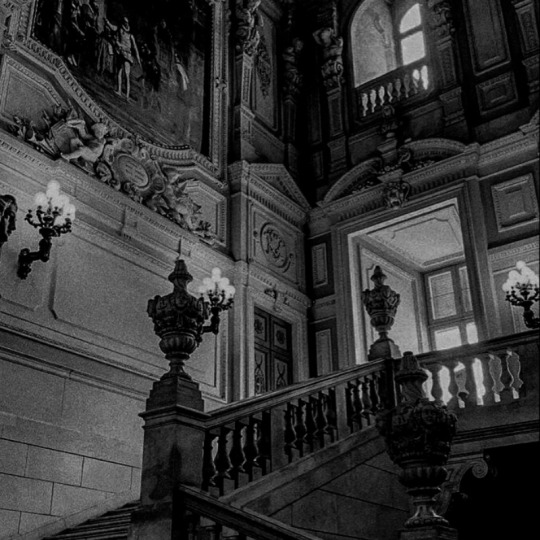

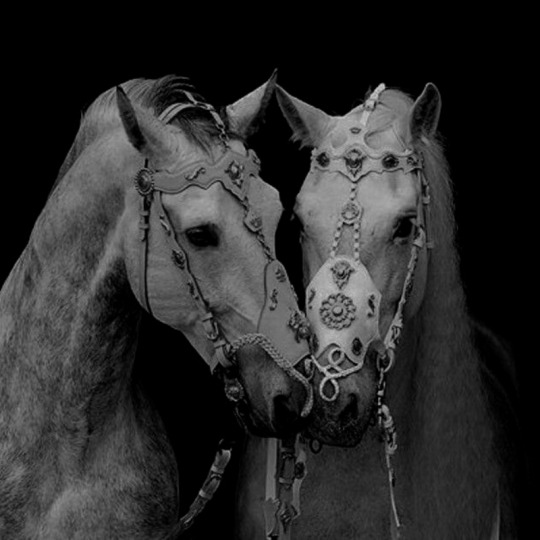

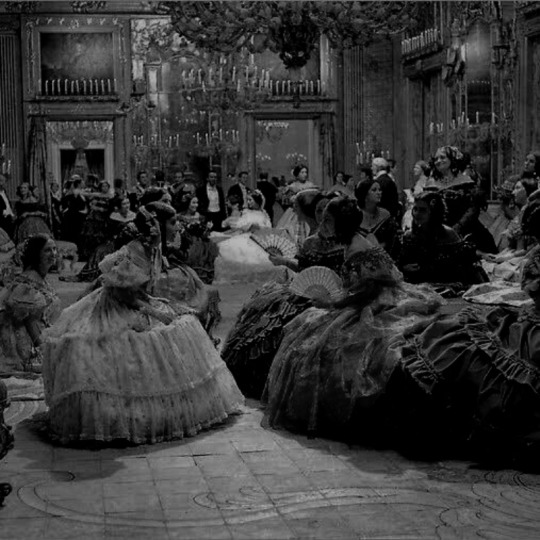

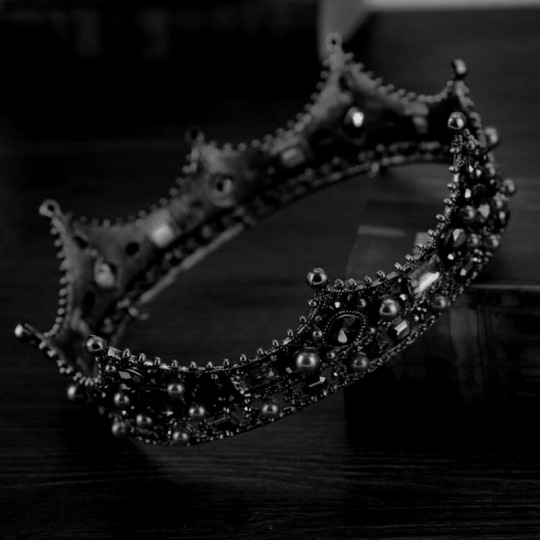

greek mythology: eukleia
eukleia is the goddess or personified spirit of good repute and glory. in greek vase paintings eukleia was often depicted amongst the attendants of the goddess aphrodite where she represented the good repute of a chaste bride.
168 notes
·
View notes
Photo
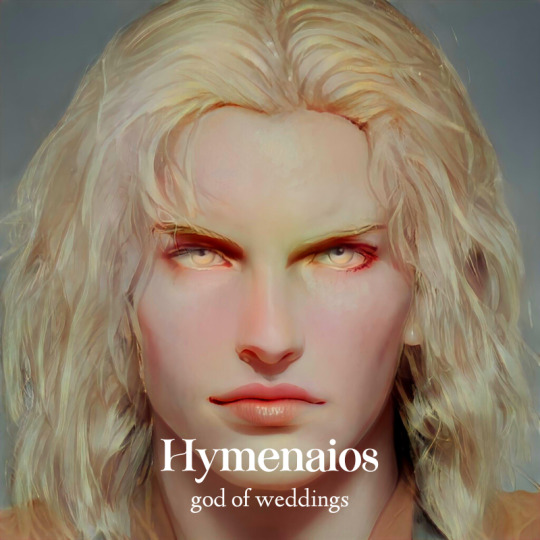


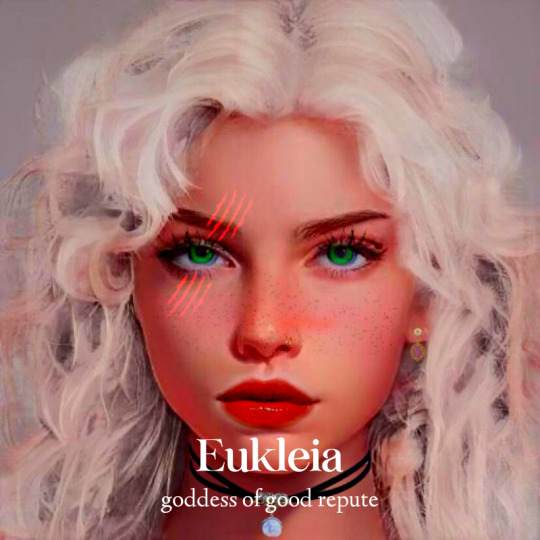

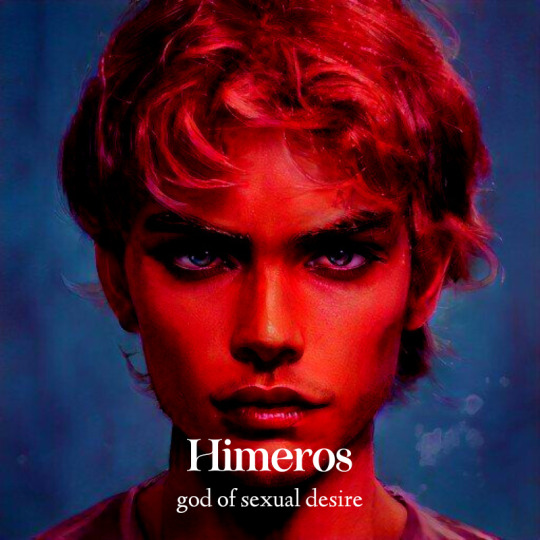



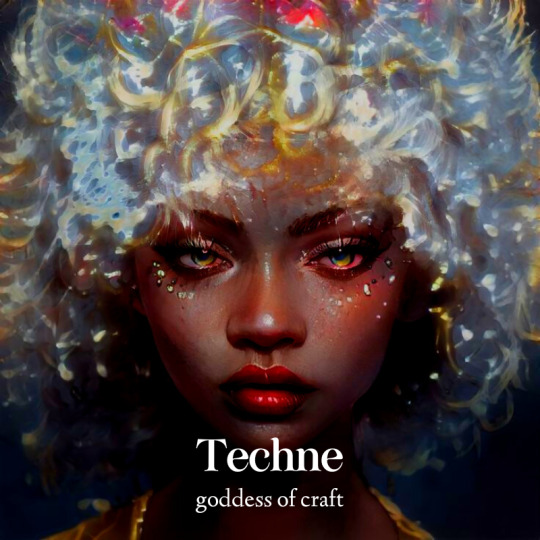
how i imagine the gods pt there’s so many gods
#here's the last one for the day#greek mythology#hymenaios#hermaphroditos#eirene#eukleia#eupheme#himeros#hedylogos#horme#ioke#techna#goddesses#gods#*#not mine#from pinterest#but the app is artbreeder
244 notes
·
View notes
Text
Igea, la dea della salute
Igea, la dea della salute
La medicina moderna ha la sua origine nel mondo antico. Le civiltà più antiche usavano la magia e le erbe per curare i loro malati, ma usavano anche la religione per liberarli dal male e per proteggere la loro salute. L’assistenza medica di oggi ha le sue radici nell’antica Grecia . Con l’introduzione di Asclepio e Igea ad Atene , nacque un culto di guarigione molto importante che esisteva dal…

View On WordPress
#Apollo#Artemis Eukleia#Artemis Aristoboule#Artista#Asclepio#Atena#Atene#Bendis#Bona Dea#Bonae Daea Hygiae#Borg#Costume#cultura#Dioniso#Donna#Emma Stafford#erbe medicinali#Erodoto#Fidia#Filosofia#fitoterapia#Grecia#Igea#Ippocrate#Iside Medica#Kanz#Leventi#Lloyd#Magia#medicina
9 notes
·
View notes
Text
Hephaestus and Aglaia’s marriage 🔨🌺
Everyone knows about the failed marriage between Hephaestus and Aphrodite but not enough people know about his later marriage with the goddess Aglaia
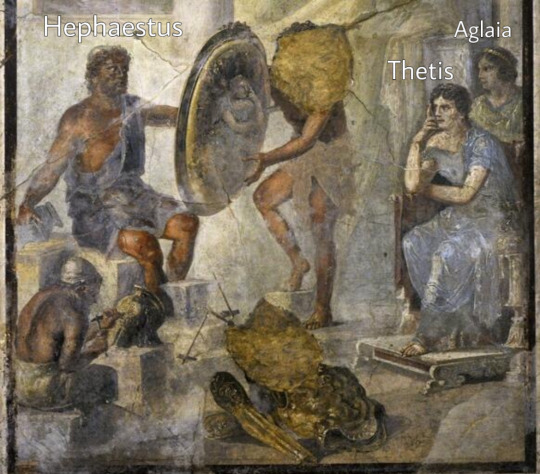
This painting from 1st A.D Pompeii is the only artwork that we have where Aglaia and Hephaestus are depicted together.
Aglaia is the goddess of beauty, splendour, glory and adornment and the youngest of the three Charites. She married Hephaestus after his divorce from Aphrodite and bore him four divine daughters:
1. Eukleia, goddess or personified spirit (daimona) of good repute and glory
2. Euthenia, goddess or personified spirit (daimona) of prosperity and abundance
3. Eupheme, personified spirit (daimona) of praise, acclamation, and shouts of triumph
4. Philophrosyne, personified spirit (daimona) of friendliness and welcome
Their marriage is mentioned in the Theogony and the Iliad. In the Iliad Thetis comes to Hephaestus’ home to ask for a new armor for Achilles and Aglaia greets her kindly, after some time the couple present the new armor to Thetis (see the picture above).
I find it so sad that Aphrodite and Hephaestus’ unhappy marriage is so popular but his loving relationship with Aglaia is mostly unknown. I love this couple and I hope that they’re happy and thriving in Olympus 💓
#greek mythology#greek gods#hephaestus deity#hephaestus#hephaestus worship#hellenic worship#hellenic polytheism
235 notes
·
View notes
Text
attendants of artemis - apotheosed maidens
aspalis ~ a girl of phthiotis who was granted immortality by artemis after her death. she became the protecting temple spirit of the goddess’ shrine in phthian melite .
britomartis ~ a girl of krete who became an immortal companion of artemis after she leapt into the sea whilst fleeing from the lustful pursuit of king minos.
hekaerge, loxo & oupis ~ three hyperborean maidens (of the mythical northern land) who became immortal companions of artemis after their death on the island of delos. they tended the goddess’ shrine on the island of delos.
iphigeneia ~ a princess of mykenai who artmemis made immortal after she was offered up to the goddess as sacrifice.
makaria-eukleia ~ a lady of thebes or attika who artemis made immortal after she sacrificed herself for her family.
parthenos & hemithea ~ two princesses of the island of naxos who were granted immortality by apollon. they became companions of artemis.
phylonoe ~ a princess of lakedaimonia who was made immortal by artemis. she was related to, if not the same as, polyboia below.
polyboia ~ a princess of lakedaimonia who was made immortal by artemus. she was related to, if not the same as, phylonoe above .
111 notes
·
View notes
Text
CHARACTER INFO SHEET
tagged by: @rexpyre (ty for tagging me!!! xoxxo <3)
tagging: @corrchoigilt @zangyo @nvrcmplt @chikyodai @memovia @ofglories @holyrisen @creaturetaled @resolutepath

Name: Patroclus | Pátroklos
Name meaning: Glory of the father
Alias: Dear-to-Zeus, Great-hearted, Gentle, Strong, Brave, Master horseman
Ethnicity: Greek
THREE HEADCANONS YOU’VE NEVER TOLD ANYONE:
He would have been one of the heroic spirits who has been part of Chaldea's story since its early beginnings. More specifically, Patroclus would've been summoned as a rogue servant and later forged a contract with Chaldea's master during the Third Singularity: Okeanos. I think he would've made an interesting addition to the team.
Not a headcanon, but killing people in fits of rage was not that uncommon in the tales of Greek heroes. Depending on who the unfortunate person was, the hero would get away with a slap on the wrist or would have to go through an intense adventure to repent for their wrongdoings. But for Patroclus to have been exiled for killing another boy, it means he either: a) Killed someone of high profile, which I find unlikely since Pat was the prince of Opus so no other boy was as 'important' as him in his homeland. Or b) it was one hell of a scandal and there was only so much damage control King Menoetius could do so he had to do the right thing and exile his only son and heir. The fact that Menoetius sent his son to King Peleus for training shows that he greatly cared for him despite his wrongdoings. I find it very interesting that Pat's name means 'glory of the father' but, at the beginning, his actions were nothing to be proud of.
But I like to think that this was the event that made him wake up and become a better man. By the time he took part in the Trojan War, Pat exemplified the virtues and values desired for an ancient greek man: courage, self-control, liberality, magnificence, honor, patience, amiability. He had become a prudent and loved-by-all man that even had epithets like the great-hearted, gentle, brave, and, when he died, his brothers-in-arms were willing to risk it all to protect his corpse and give him a proper burial. By the end of his life, he really was the glory of his father. I'm obsessed with his character development!
THREE THINGS YOUR CHARACTER LIKES DOING IN THEIR FREE TIME:
Long walks on the beach
Spending time with his friends
Riding (horses) and driving
SIX PEOPLE YOUR CHARACTER LIKES/LOVES:
Achilles
Menoetius (his father)
His mother (Philomela, Polymele, Damocrateia, Periopis, or Sthenele, for some reason no one seemed to agree on the mother's name)
Myrto (younger sister)
Eukleia (niece)
Honorable mention to all the Achaean soldiers with whom Pat formed a close bond over the years fighting side by side, and not only admired him as a soldier but trusted him as a friend to whom they could show vulnerability and even cry before him.
TWO THINGS YOUR CHARACTER REGRETS:
Not being a better son: Already mentioned how he brought shame to his family due to his actions and had to face the consequences for that, but, besides that, to this day he regrets not being thankful enough, not apologizing enough, not saying I love you enough, etc.
The end: He doesn’t regret his actions close to the end of his life, he doesn't regret the way he died, he doesn't regret disobeying and going against what the gods had in mind, and he doesn't regret that he ended up hurting his loved ones. Because it was the right thing to do and, for his brothers-in-arms, he would do it again. But he regrets the fact that he didn't try harder to stop things from reaching that point of no return, that there was no other solution available, that maybe he could've done something and less people would've died because of his lack of action.
TWO PHOBIAS YOUR CHARACTER HAS:
Atelophobia / Fear of imperfection: But more specifically regarding his philotimo or ‘love of honor’. Philotimo is a person’s inner awareness of their dignity and pride that motivates them to fulfill their social responsibility and duty even if it puts them at a personal disadvantage. Honor is derived from doing things for others that are beyond one’s own self-interest, whether it be to their family, friends, or country.
I wouldn't really call it a phobia in Pat's case, but tied to the fear mentioned above is the fear of failure.
#pat. º ( lancer. )#tagged. ° ( thank you! )#hc. ° ( shooting star. )#/ can you tell i got all the pat brain worms? can you tell im reading the iliad again? can you tell that -falls to the floor and cries-#/ long post
11 notes
·
View notes
Text
Interesting fact, the only source that mentions the daughters of Hephaistos and Aglaia (Eukleia, Euthenia, Eupheme, Philophrosyne)is Proclus' commentary on Plato's Timaeus, listed as one of the Orphic Fragments. Hesiod, who also mentions the union of Hephaistos and Aglaia, strangely doesn’t name any children born to them as he does for most other divine couples in the Theogony.
3 notes
·
View notes
Text
Ayauhteotl

Ayauhteotl roughly translates as the Mysterious Goddess of Nature who controls the mist.
IMAGE: See symbols, otherwise unknown.
SYMBOLS: Mist, Crepuscular rays, smoke.
AREAS OF CONTROL: Ayauhteotl was the being, force, or Goddess who both was and controlled mist, smoke, and, most notably, Crepuscular rays, the dark and light beams that appear under the proper condition at sunset; she was also the Goddess of fame & glory.
HOLY BOOKS: Books of Black & Red (Metaphor for knowledge among the Aztecs, this is also what their painted books are referred to as.) Duran, Diego’s “Book of the Gods and Rites and the Ancient Calendar ”
SACRIFICES: Of course, the Aztec people were famous for using human sacrifices to appease some deities. Were such used for Ayauhteotl? I don’t know; however, it seems that some sacrifice was demanded by all Gods & Goddesses, though it could be as simple as tossing a bit of cornflower into the fire before baking. I will not speculate on what a Goddess of fame, glory, and mist would demand.
RELATIVES: Toci (grandmother), Teteo Inan (mother), Tlazoteotl Ixcuina, Goddess of Vice. Iltzpaplotl Obsidian Knife Butterfly, Goddess of sensual sex & violent death (Sisters.)
SYNODEITIES: Sekhmet sunset’ (Egyptian), Klymene or Pheme Goddess of fame (Greek), Eukleia Goddess of glory (Greek), Titania Queen of the Fairiesglamour’ (British Isles), Yina’ mna'ut “Fog Woman,” Yina'mtilan “Fog Man” (Siberian.)

DETAILS: The Aztecs had a saying, “Poctli, ayauitl: Tenyotl, mauizyotl,” which meant Smoke and mist: Fame and glory. Another of their aphorisms used to denote a remarkable person who had come onto the scene and impressed everyone was “Mixtitlan, Ayauhtitlan,” or From out of the clouds, from out of the mist.
To the Aztec great renown and public magnificence were seen as a mist that spread out from that person clouding and distorting everything near them.
As a people with thousands of God & Goddesses, ranging from minor household spirits to deities who watched over certain rivers, lakes, or cities to powerful Gods who were said not j to represent but to be massive forces such as rain, fire, and death or abstract ones such as war, song, or fearful sex, the being who was both fame & glory as well as smoke & mist was Ayauhteotl.
The TL at the end of Her name was a designation of a divine force beyond reckoning.
While many of their gods were based on people who had been deified or concepts that were seen to have a life of their own, those designated with a TL were seen as a class apart.
Outside human understanding, they were forces of nature that one could, at best, hope only to ride along with like a surfer on top of an overpowering wave.
As such, those who sought recognition and admiration implored Ayauhteotl to surround them, or perhaps those who found themselves in that situation hoping to obtain mercy from her.
You see, Ayauhteotl was not just seen as any mist. Her main form was the mist known as crepuscular fog.
Those amazing bright and dark bands that, under the right conditions, seem to come out of clouds near sunset.
I think this tells us something about the Aztec Goddess of fame & glory. She, like those rays, is hard to ignore; however, note they always come just before sunset, so no matter how great their magnificence, the very thing that brings them into being dictates that their lives will be brief.

12 notes
·
View notes
Text
Theoi woman series masterpost—
if i missed a woman send me an ask and i will draw her and add her name to this post

ACHLYS
ADEPHAGIA
AGLAEA
AEDOS
AEGINA
AEGLE
AETNA
AGLAEA
AKESO
AMPHITRITE
ANDROEDA
ANTHEIA
APHRODITE
ARAKHNE
ARETE
ARIADNE
ARTEMIS
ASTERIA
ASTRAPE
ATHENA
ATROPUS
AURA
BENDIS
BEROE
BRITOMARTIS
CABEIRI
CALLIOPE
CASSANDRA
CETO
CHIONE
CHLORIS
CHRYSOTHEMIS
CIRCE
CLYMENE
CLIO
CYMOPOLEA
CYRENE
DAEIRA
DANAE
DAPHNE
DEINO
DELPHIN
DEMETER
DESPOENA
DIKE
DORIS
DYSIS
EILEITHYIA
EIRENE
ELETE
ELEUSIS
ENYO
EOS
EPIONE
ERATO
ERIS
EUKLEIA
EUNOMIA
EUPHEME
EUPHROSYNE
EUPORIA
EURYBIA
EURYDICE
EURYNOME
EUTERPE
EUTHENIA
GAIA
GYMNASTICA
HARMONIA
HEBE
HECATE
HEDONE
HELEN
HELLE
HEMERA
HERA
HESPERIS
HESTIA
HYGEIA
IASO
IPHIGENIA
IRENE
IRIS
KETO
LETO
LEUCIPPIDES
MEDEA
MEDUSA
MELINOE
MELPOMENE
MNEMOSYNE
MINTHE
NIKE
PANACEIA
PANDIA
PANDORA
PEITHO
PENELOPE
PERSEPHONE
PHILOPHROSYNE
PHOEBE
POLYHYMNIA
PSYCHE
RHEA
SELENE
STYX
TERPSICHORE
TETHYS
THALEIA
THALIA
THEIA
THEMIS
THETIS
THYONE
TYCHE
URANIA
3 notes
·
View notes
Text
Welterbe (auf)gespürt und (er)fahren – GR – Archäologische Stätte von Aigai (heute Vergina)

Die alte königliche Hauptstadt Mazedoniens, Aigai, wurde im 19. Jahrhundert zwischen den heutigen Dörfern Palatitsia und Vergina in Nordgriechenland entdeckt. Hier lebte einst die königliche Dynastie der Temeniden mit ihren bedeutenden Herrschern Philipp II. (um 382 - 336 v. Chr.), der alle griechischen Städte eroberte und seinem Sohn Alexander dem Großen (356 - 323 v. Chr.) den Weg für die Expansion der hellenistischen Welt ebnete. Die archäologische Stätte von Aigai besteht aus den Ruinen der ältesten und wichtigsten Stadt in Nordgriechenland und mehreren umliegenden Siedlungen. Bisher wurden der reich mit Mosaiken und bemaltem Stuck verzierte monumentale Palast als eines der beeindruckendsten Gebäude des klassischen Griechenlands, das Theater, die Heiligtümer von Eukleia und der Mutter der Götter und die Stadtmauern ausgegraben. Aigai liefert damit wichtige Informationen über die Kultur, Geschichte und Gesellschaft der alten Mazedonier, die die griechische Kultur bewahrten und bis an die äußersten Grenzen der antiken Welt trugen. Die königliche Nekropole besteht aus mehr als 500 Grabhügeln aus dem 11. bis 2. Jahrhundert v. Chr. Hier wurden bis jetzt drei königliche Grabgruppen mit zwölf monumentalen Tempelgräbern ausgegraben. Darunter befinden sich das Grab von Euridice, der Mutter von Philipp II., sowie die 1977–1978 entdeckten und noch ungeplünderten Gräber von Philipp II. und seinem Enkel Alexander IV. . Aigai steht als eine der wichtigsten archäologischen Stätten in Europa seit 1996 auf der UNESCO-Welterbeliste.
Die archäologische Stätte von Agai liegt in dem kleinen Ort Vergina mitten in einer landwirtschaftlichen Ebene. Bei meiner Ankunft entdecke ich am Ortseingang ein großes modernes Museum. Die Ausgrabungsstätte ist von dort gut ausgeschildert, trotzdem muss ich mich durch die engen Dorfstraßen schlängeln, bis ich schließlich auf dem großen Parkplatz ankomme. Es ist heiß geworden, ein alter Bauer schenkt mir beim Vorbeigehen an seinem Stand einen Apfel. Das ist jetzt genau das richtige nach der langen Fahrt. Die Ausgrabungsstätte um den Tempel ist geschlossen, es sieht aus, als wären hier gerade die Historiker am Werk.
Der Zugang zum Königsfriedhof ist von Ständen gesäumt, die jetzt, Ende September, auf Besucher warten.

Schließlich stehe ich in einer Art Park vor einem flachen großen Hügel und bin schon etwas enttäuscht, bis ich den Eingangstunnel entdecke und dadurch in das Innere des Hügels gelange.
Und hier verschlägt es mir fast den Atem. Ich stehe mitten zwischen den historischen Grabkammern und vor ihren verzierten und bemalten Eingangstoren. Durch den unterirdischen Raum weht förmlich der Hauch der Geschichte.
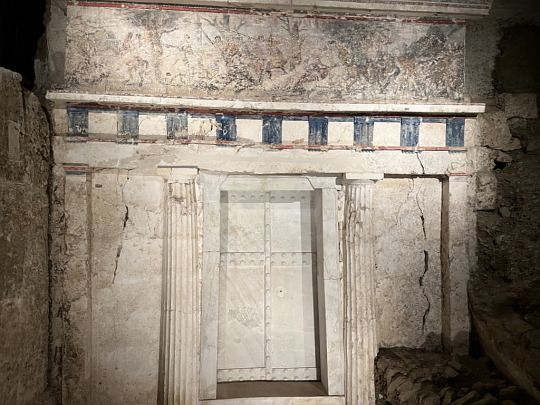


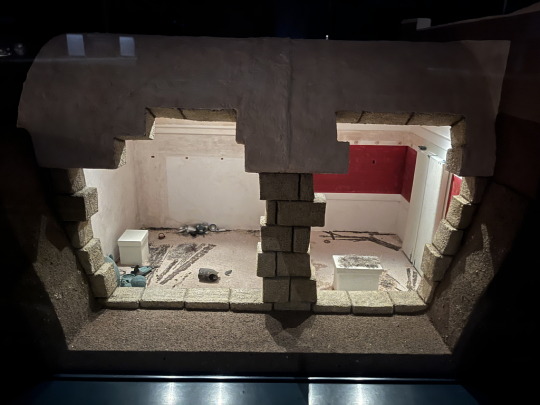
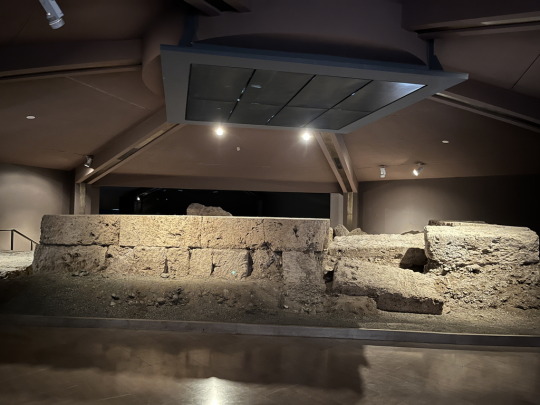
An einer Wand sind die vergrößerte Repliken der Malereien auf dem Marmor an den Portalen ausgestellt und so kann ich ihre Details von Nahem bestaunen.
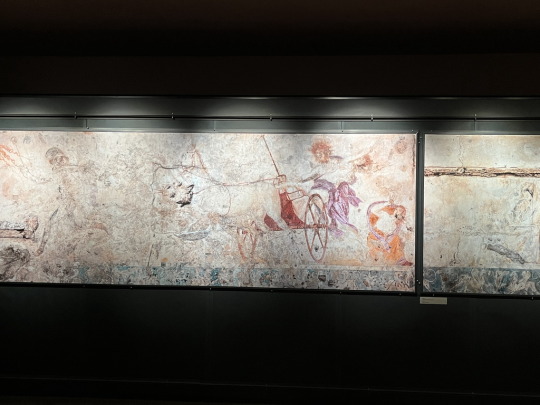
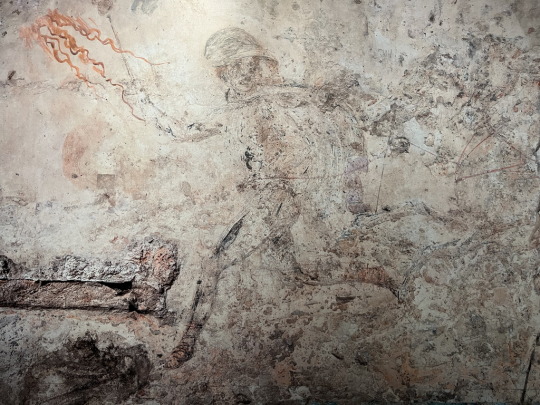


Und nicht nur das - in den Vitrinen ringsum sind Fundstücke zu sehen, Schmuck aus Gold und Edelsteinen, Reliefs und Skulpturen, Münzen und Wandmalereien. Sie wirken in dem dunklen Raum dezent beleuchtet besonders eindrucksvoll und untermalen die Stimmung der gesamten unterirdischen Grabhalle.



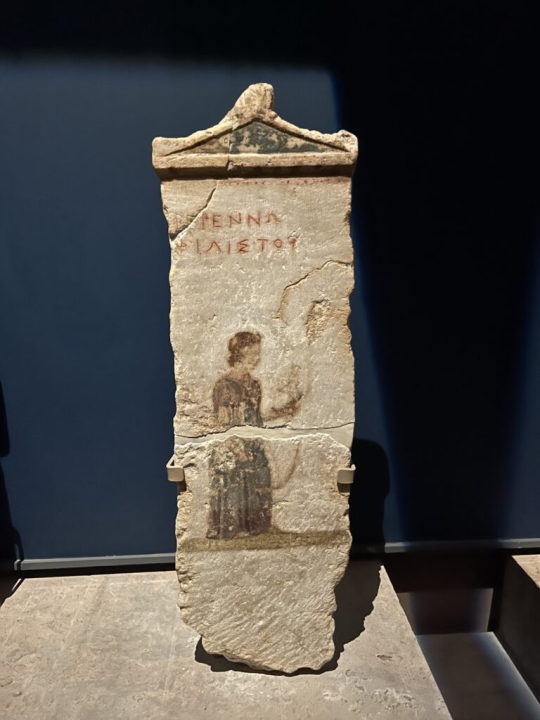
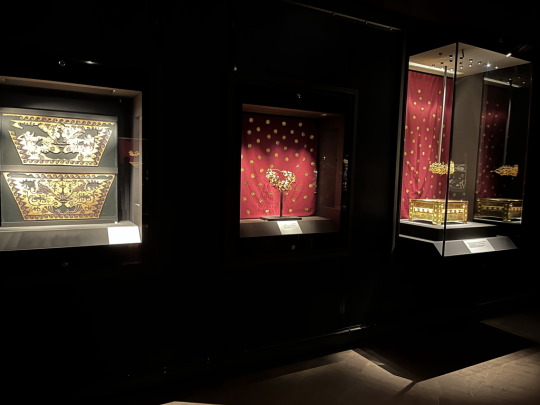


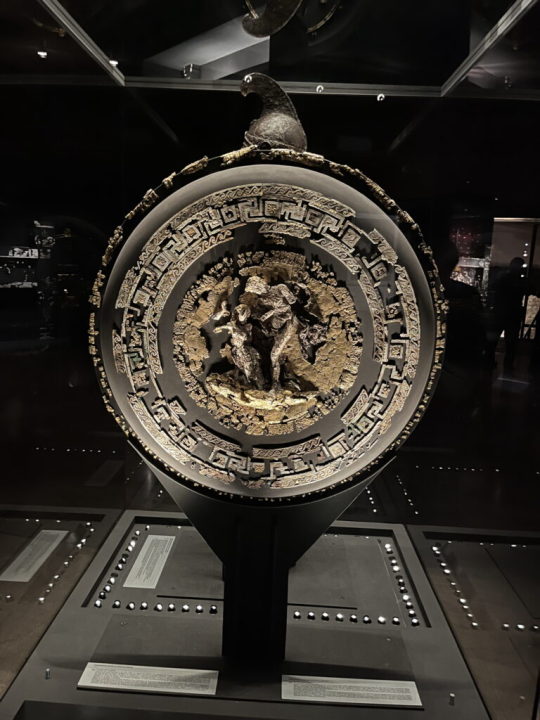

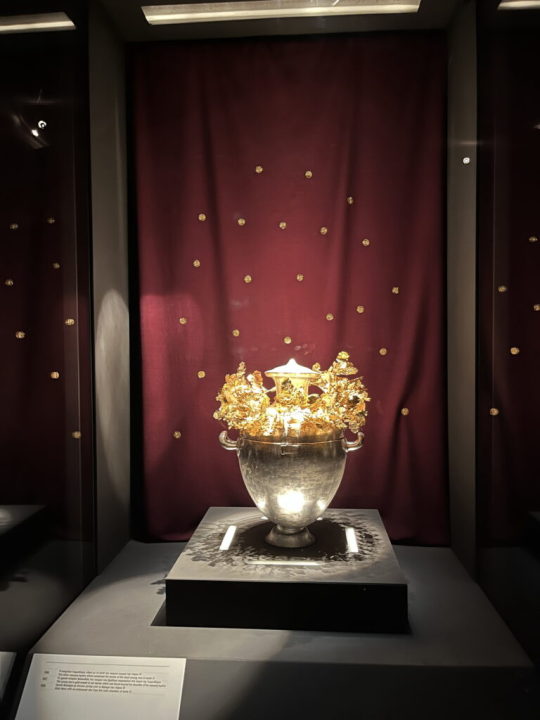


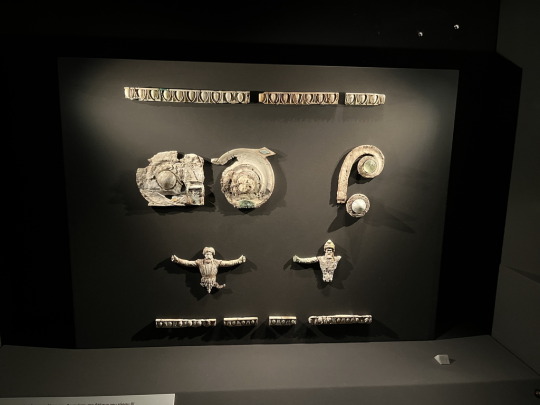
Natürlich ist all das ebenso gut beschrieben wie präsentiert, ich erfahre viel Interessantes. In einem abgetrennten Raum berichtet eine filmische Dokumentation über die Ausgrabungen.



Als ich nach diesem aufregenden Besuch wieder ans Tageslicht trete, muss ich in der Sonne blinzeln. Da der zweite Teil der Ausgrabungsstätte zur Zeit nicht zugänglich ist, fahre ich zum Welterbezentrum am Ortseingang. Hier erwartet mich eine moderne Ausstellung über die Stadt Agai mit vielen Details zum Leben, Geschichte, Bauwerken und Ausgrabungsstücken. Auf Videos neben den Vitrinen werden Details der ausgestellten Stücke gezeigt, die mir beim Betrachten sonst gar nicht aufgefallen wären. Dieses Museum ist eine wirklich wertvolle Ergänzung zu den Königsgräbern.

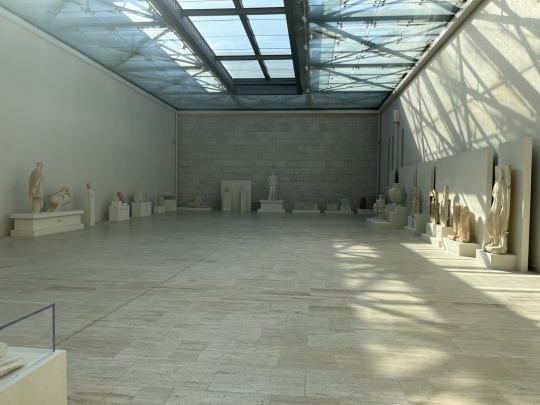
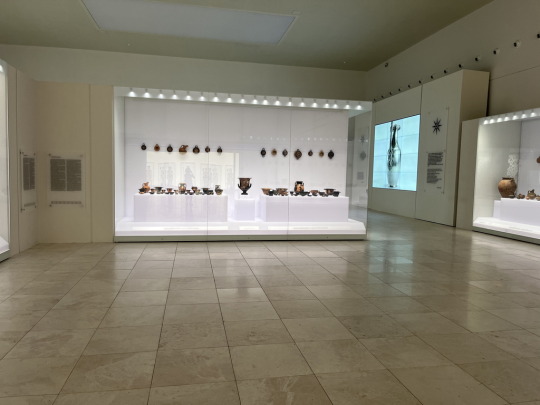



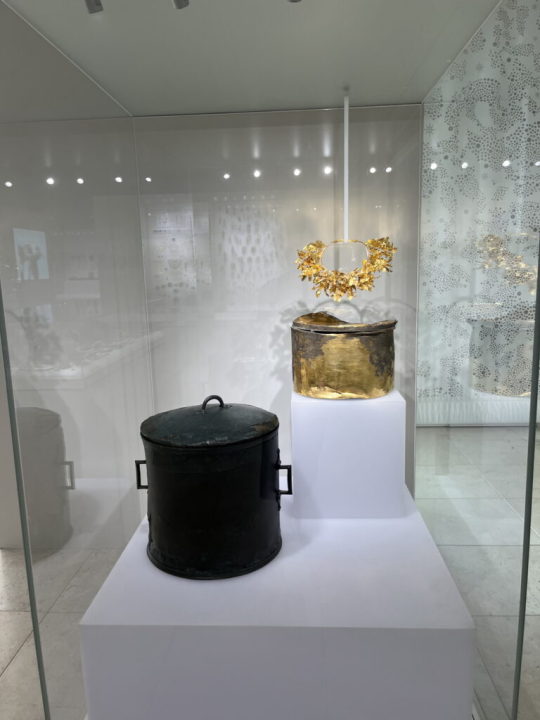
Resümee
Vergina war für mich eine echte Überraschung, ganz besonders beim Eintritt in das unterirdische Museum der Königsgräber. Eine solche fantastische Präsentation hatte ich hier in dem kleinen Dorf weit abgeschieden auf dem Land nicht erwartet. Die Ausstellung um die Gräber ist mehr als stimmungs- und eindrucksvoll, man sollte also ausreichend Zeit mitbringen, um alles zu betrachten und zu erspüren. Das moderne Welterbezentrum macht mit seiner Ausstellung mehr als wett, dass die Ausgrabungsstätte um den Palast gerade nicht besichtigt werden konnte. Und für alle fahr- und pflastermüden Besucher ist der kleine Ort mit Restaurants und Frischmärkten kulinarisch auf seine Gäste bestens vorbereitet.
Auch ich habe einen Gast, der sich mit mir mein Picknick vor der Weiterreise teilt.

Die gesamte Tour go-south 3.0 ist hier beschrieben. Hier gehts zu meinem Welterbe-Projekt. Der Umbau meines Dacia Dokker als Minicamper ist hier detailliert nachzulesen. Dobbys Einrichtung und Ausstattung hat sich auch in diesem Herbst und seinen Gewittern bewährt. Meine Übernachtungsplätze habe ich wieder auf park4night gesucht und unter 5Reisende bewertet. Die zusammengefassten Länderkarten gibt es hier.
Read the full article
#Abenteuermobil#Abenteuerreise#Albanien#alleinunterwegs#Alleinreisen#Ausbau#Ausrüstung#Autoreise#Besichtigung#BosnienundHerzegowina#Camping#Camping-Mobil#Dacia-Dokker#DIY#Dobby#Erfahrungsbericht#Erkundung#Europa#Hochdach-Kombi#Inspiration#Kroatien#Leichtbau#Minicamper#Montenegro#Parkplatz#Reisebericht#Reisefotografie#Reisetagebuch#Reiseziele#Roadtrip
0 notes
Photo
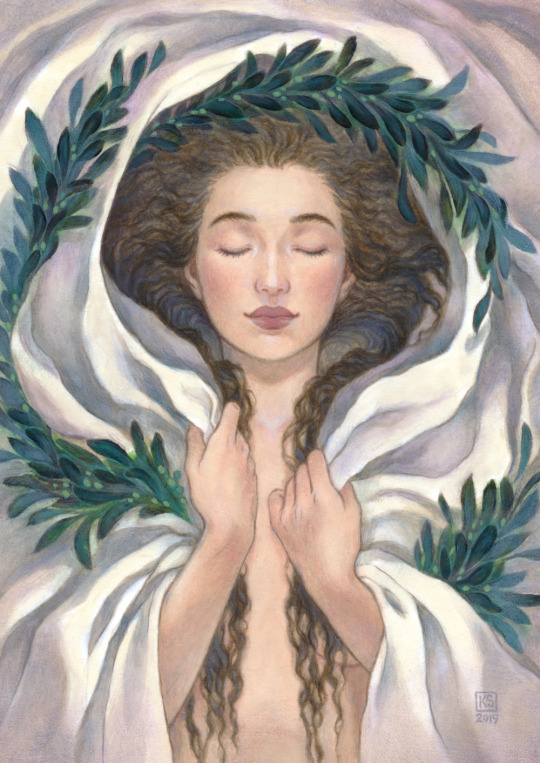
'Eukleia' by Kaysha Siemens for Every Day Original, part of her ongoing 'Mnemosyne' personal project inspired by Greek mythology.
5" x 7" Oil on board original artwork for $425.
On sale Friday November 22 at 12.30pm ET from the Every Day Original website.
#Art#Kaysha Siemens#Eukleia#Greek Mythology#Goddess#Female#Feminine#Original Art#New Contemproary Art#Portrait#Fantastical Art#Imaginative Realism#Fantastical Realism#Mnemosyne#Mythology
15 notes
·
View notes
Text
other companions of the horae and associated gods
This post deals with textual mentions of the Horae but will also have a focus on art that they are in, mostly pottery, and the figures they accompany in those pieces as the triad and on their own. You can find my other posts on the Horae, including the run-down on them as companions to Olympian gods HERE.
THE HORAE
“Meanwhile the rich-tressed Kharites and cheerful Horai dance with Harmonia and Hebe and Aphrodite, daughter of Zeus, holding each other by the wrist." - Homeric Hymn 2 to Pythian Apollo
The Horae are often pictured amongst Aphrodite’s retinue, including the Erotes, Harmonia, and the Kharites. As previously mentioned, they are attendants to Aphrodite, as well as to Hera and Persephone. They are also sometimes depicted in art at the side of Dionysos, Apollo, and Pan.

(The Horae dance towards Pan)
When the Horae are placed together they are typically portrayed together as the set of three and not as a pair (I have found very few exceptions, most of which are vase art where the figures are not named or have lost their names and it is proposition that Eunomia and Dike or Eirene and Eunomia are pictured, not certain.) Outside of this they are seen with other gods on their own. I’ll be discussing both the gods they appear with, and the gods they are closely identified with - starting with the Kharites who fit into both of those categories.
The Kharites are very intertwined with the Horae. Both groups of goddesses are handmaidens to Aphrodite so it is not uncommon to see them together in art. The Kharites (also Graces) are the goddesses of grace and everything else which can be summed up as “life’s pleasures” (such as beauty, relaxation, happiness, banquets, laughter, dance and song) also numbered three and occasionally of different groups called the older and younger Kharites.
In Athens, the triad of Horae Thallo, Auxo, and Karpo were worshipped as both Horae and Kharites (also, Pausanias claims that Auxo and Hegemone [another name for one of the Horae] were worshipped in Athens only as Kharites.)
In modern polytheist circles they are often confused or considered to be the same as each other, which doesn’t not make sense. They share so many similarities that it would be more surprising if they weren’t. My main suggestion for separating the two is that the Kharites are called naked and in some (not all! sometimes they are still clothed which again makes it harder) ancient art are portrayed without any clothes while the Horae are never naked, but may be seen with one or both of their breasts shown.
Also, the Kharites are mostly called the daughters of Zeus and Eurynome and sometimes of Dionysos, but the Orphic Hymns call them daughters of the Hora Eunomia which I will talk a little bit about further down.
Before moving on to them individually I also want to make a note about the Themeides which I made a small mention of in my first post. The Themeides nymphs are another triad of goddesses born to Themis and Zeus. To quote Theoi they are “the keepers of certain artifacts of the gods”, and they also gave their aid to Perseus and Herakles. They, as nymphs, also represent nature in a way which can be easily related to the Horae. It is possible then that they may be the Horae or that they are simply their sisters.
EUNOMIA
Often portrayed in pottery alongside Aphrodite’s retinue without the other Horae (Eunomia is more present alongside the goddess in art than either Eirene or Dike are), she is seen most often with Eukleia and sometimes Harmonia.
“[AND ARETE] with garland-loving Eukleia steers the city, she and wise Eunomia, who has festivities as her portion and guards in peace the cities of pious men.” - Bacchylides, Fragment 13
Eukleia is the goddess of good repute, and had a particular association with and worship from brides. (Eukleia is also an epithet of Artemis in which she was worshipped the same way by upcoming brides and bridegrooms.) Her association with marriage makes it more clear as to why she is so commonly found with Eunomia - and with Harmonia as well. I see the three of them as being Eukleia leading up to marriage, Harmonia representing the actual marriage and wedding, and Eunomia being the balance and lawfulness throughout the rest of the marriage. Also, as in the quote above, Eukleia (good-repute) guides the city and Eunomia (good-order) keeps it running.

(Eukleia approaching Eunomia with a chest/gift)
Eunomia is associated with Eurynome, Okeanid of water-meadows/flood-meadows and general pastureland (the ending of both their names, nomia, means pasture. Eunomia is a goddess of spring pastures.) who bore the Kharites to Zeus. The Orphic Hymn to the Kharites also names Eunomia as their mother instead of Eurynome. Because of her association with or perhaps replacement of Eurynome, Eunomia is often seen along with the older and younger Kharites.
“Hear me, illustrious Kharites, mighty named, from Zeus descended, and Eunomia famed[...]” - Orphic Hymn 60 to the Kharites
EIRENE
“Open of yourselves, you doors, for mightly Ploutos will enter in, and with Ploutos comes jolly Euphrosyne and gentle Eirene." - Homer’s Epigrams 15
The god Ploutos is often depicted as an infant being held in the arms of Eirene in verse, statue, and vase. Ploutos is the god of wealth (both in the sense of a bountiful harvest and in gold) and son to Demeter. This imagery of her often holding or doting over the young Ploutos suggests that she is his nurse, and that idea/imagery is shared with Tykhe the goddess of fortune. There is very little to suggest that Eirene was considered a possible mother to him instead of Demeter- in fact the only two instances I’ve seen of such did not quote any ancient idea about the relationship and are possibly just UPG. In addition, though they are sometimes swapped to share the same role as nurse, Tykhe is sometimes called his mother where Eirene is not which I think is important. In vase, Athena can be seen in addition to Eirene and Ploutos.
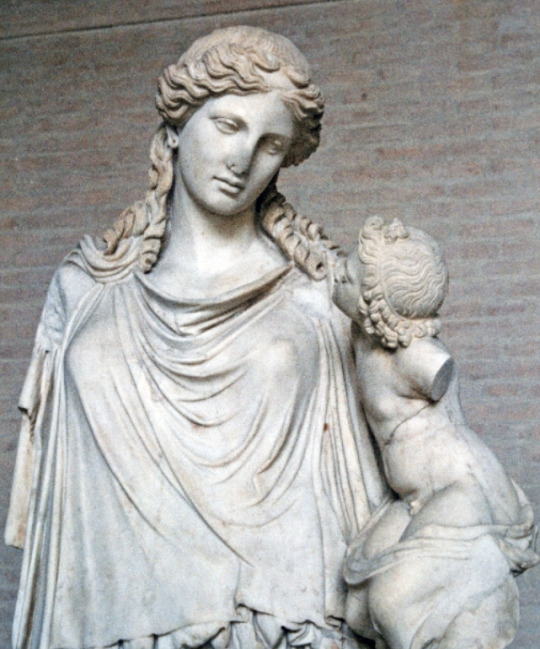
(Eirene holding the baby Ploutos)
Eirene may have been synchronized with one of the other, possibly “younger”, Horae of a different group, Thallo. Thallo’s name according to Theoi means green-shoots and/or blooming (thallos), which Eirene is also associated with. In the Theogony, Hesiod uses “Thallo” as an epithet to Eirene and not as a name of a distinct figure. Similarly, she is given the epithet “Hesykhia” which is the name of the proposed daughter of her sister Dike, the goddess of stillness, quiet, and rest.
More modernly, Eirene has become associated with Harmonia. This is not me trying to say how anyone should worship them, I just wanted to give my opinion on this. While peace and harmony are obviously related and pretty much synonyms, I don’t believe that Eirene and Harmonia are goddesses of the same thing. To me, Eirene resembles peace more as a condition of the state/city. Her aspect of peace is peacetime in contradiction to war. Harmonia on the other hand, strikes me more as a goddess of personal harmony. She is harmony in relationships (romantic or otherwise) and the actual peaceful feeling. Again, other people may certainly think differently. That’s just my two cents.
DIKE
Dike is closely identified with both Astraea and Dikaiosyne, all who are described as virgin goddesses of justice. Most of what we know of Dikaiosyne comes from her single hymn, Orphic Hymn 63, where her reign is described nearly indistinguishable from Dike. Astraea has a bit more information. Daughter of Astraeus, it’s said that Zeus placed her among the stars as the constellation Virgo when she left earth because of the lawlessness of man. Astraea is given as an epithet to Dike, closer implying their relationship as being perhaps one single goddess.
It is possible also that Praxidike is associated with her. Said to be a personification of exacting justice, her name functions also as an epithet- specifically to Persephone and the Erinyes.
One companion she has in text is Horkos, son of Eris, god of oaths, and punisher of those who commit perjury. His connection to perjury and exacting justice places him alongside Dike. To be explained in a further post, they share the fifth day of the month as being sacred to them (as well as with the Erinyes, again.)
“The better path is to go by on the other side towards justice; for Dike beats Hybris when she comes at length to the end of the race. But only when he has suffered does the fool learn this. For Horkos keeps pace with wrong judgements.” - Hesiod Works and Days 218
Sadly there seems to be very little recovered art of Dike which isn’t presented as three Horae in a scene together. There is, however, pottery with Dike pictured beating Adikia (injustice) with a weapon!

(Dike beating Adikia with a hammer)
#The Horae#The Horai#hellenic polytheism#hellenic paganism#helpol#greek religion#greek pantheon#Dike deity#Eirene deity#Eunomia deity#personal
14 notes
·
View notes
Photo

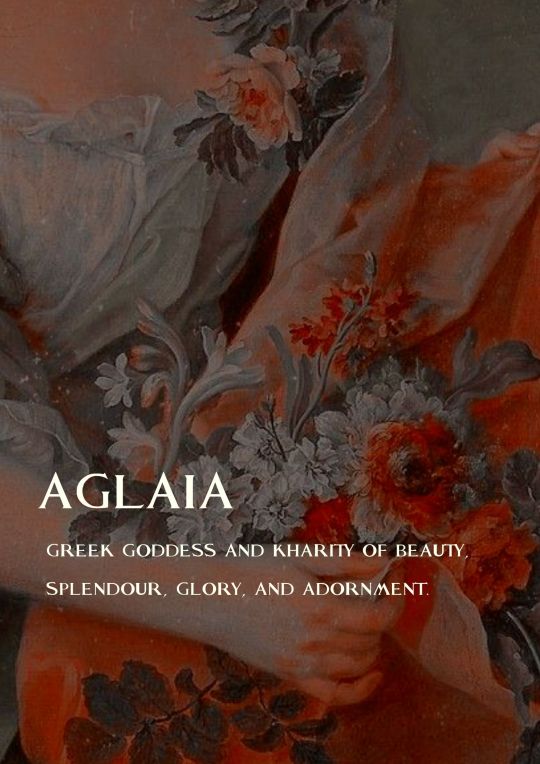
greek mythology | gods & goddesses | Αγλαια
→ aglaia was the greek goddess and kharity of beauty, splendour, glory, and adornment. she was the wife of the god hephaistos and the mother of four younger kharites named eukleia, euthenia, eupheme and philophrosyne.
#greek mythology#greek myth#greekmythologyedit#greekmythedit#greekedit#mythologyedit#mythedit#myedit#mine#gods and goddesses#aglaia#goddess of splendour#aesthetic#graphics#hephaestus
190 notes
·
View notes
Text
Theoi Summary - Hephaistos
Ἡφαιστος (EE-fays-tohs) - Hephaistos AKA Hephaestus
God of fire, smiths, the disabled, craftspeople, metalworking, sculpture, volcanos, and stonemasonry
Ouranic Olympian with Chthonic aspects
Symbols: Hammer, tongs, anvil, fire, forge, volcano
Animals: Donkey, crane, dog
Colors: Red, bronze, grey, orange
Plants/Herbs: Fennel
Stones/Crystals: Bronze, marble, metals
Retinue: Kyklopes, Kabeiroi, Kourai Khryseai, Kedalion
Relations: Hera (mother), Zeus (sometimes father), Aphrodite (ex-wife), Aglaea (wife), Kabeiroi (sons), Eupheme (daughter), Eukleia (daughter), Euthenia (daughter)
Identified with: Vulcan (Roman), Ptah (Kemetic)
Festivals: Khalkeia (29 Pya.), Hephaistia (??)
Epithets: Clytus (Renowned), Clytometis (Famed for Skill), Clytotechnes (Famed worker), Polytechnes (Of Many Crafts), Polyphron (Ingenious), Polymetis (Resourceful), Aethaloïs Theus (Sooty God), Chalceus (Bronze/Coppersmith), Cyllopodium (Crooked-Foot), Amphigyeis (Lame One)
#theoi#hellenic polytheism#hellenic paganism#hellenismos#olympian gods#grimoire#deity summary#theoi summary#witchblr#ouranic theoi#chthonic theoi#hephaistos#hephaestus#hephaestus god
37 notes
·
View notes
Text
The Kharites
The Kharites are the goddesses of kharis (grace), personal beauty and adornment, and pleasures such as feasting, relaxation, and joy. They are also the goddesses of charming speech and song as well as festive dance and song. They are the attendants of Aphrodite and Hera.
“They are mostly described as being in the service or attendance of other divinities, as real joy exists only in circles where the individual gives up his own self and makes it his main object to afford pleasure to others. The less beauty is ambitious to rule, the greater is its victory; and the less homage it demands, the more freely is it paid. These seem to be the ideas embodied in the Kharites. They lend their grace and beauty to everything that delights and elevates gods and men.” (theoi.com)
This idea of the Kharites giving their grace to others makes sense when you remember the meaning of kharis: a reciprocal relationship with the gods in which mortals make offerings to the theoi.
The Kharites, especially Algaia as the wife of Hephaistos, also represented artistic beauty. Like the Mousai, they were said to have inspired and favored certain artists, and the gracefulness and charm associated with Hermes (words), Peitho (persuasion), Aphrodite and Eros (love), and even Athena (wisdom) is said to come from them. The Kharites were often depicted as companions of Apollon and the Mousai and were said to live with the Mousai on Olympus. Poetry was thought to be their favorite of the arts.
“Poets are inspired by the Muses, but the application of their songs to the embellishment of life and the festivals of the gods are the work of the Kharites.” (theoi.com)

According to Hesiod, the three elder Kharites were daughters of Zeus and the titan-goddess of meadows, Eurynome. Their names were Algaia (sometimes Kharis or Kale/Kalleis), Euphrosyne, and Thaleia.
Algaia was Hephaistos’ second wife and bore by him the younger Kharites: Eukleia, Euthenia, Eupheme, and Philophrosyne. Although not numbered amongst Algaia’s children, Pasithea, the wife of Hypnos, was called a younger Kharis by Homer.
Elder Kharites
Euphrosyne
the goddess of good cheer, mirth, merriment, and joy
her name means “merriment”
Thaleia
goddess of festivity and banquets
her name means “luxurious banquet” or “the blooming”
Thallo, an Hora and goddess of spring buds, was likely confused with Thaleia because of her association with blooming. Thallo herself was more commonly just an epithet of Eirene, one of the Horai and the goddess of peace.
Algaia
youngest of the elder Kharites
goddess of beauty, splendor, glory, and adornment
mother of the younger Kharites by Hephaistos
also called Kharis (grace) or Kale (beauty)
Younger Kharites
Eukleia
goddess of good repute and glory
As Aphrodite’s attendant, she represented a bride’s good repute.
Euthenia
goddess of prosperity and abundance
opposite of Penia (poverty)
Eupheme
goddess of praise, acclamation, and shouts of triumph
opposite of Momos (critique)
Philophrosyne
goddess of friendliness and welcome
Pasithea
goddess of rest and relaxation
Hypnos’ wife and probably the mother of the Oneiroi and Morpheus
She was promised to Hypnos by Hera after he helped her put Zeus to sleep during the Trojan war. Some have interpreted this to mean she is Hera’s daughter. Another source calls her a daughter of Dionysos.
“Pasithea as the wife of Hypnos, god of sleep and dreams, may have been envisaged as the goddess of hallucinations and hallucinogenic drugs. Her name is difficult to translate--the prefix pasis can be translated equally as "all," "possessed," or "acquired" and the suffix -thea as "sight," "seeing," "contemplation," "goddess," or "divine." Translating it as "Acquired-Sight" may suggest a goddess of hallucination, however, in the story of the Iliad, where Hypnos acquires her from Hera in exchange for certain favours, the "Acquired-Goddess" meaning is quite apt. The name pasithea was also given to some unidentified "magical" plant, perhaps even an hallucinogenic. Hypnos was himself associated with poppies and opiates.” (theoi.com)
Other named Kharites
Kharis attendants of Aphrodite depicted in vase painting:
Antheia - goddess of flower wreaths worn at festivals
Eudaimonia - goddess of happiness, prosperity, and opulence
Paidia - goddess of play and amusement
Pandaisia - goddess of rich banquets
Pannykhis - goddess of nighttime festivities
The Spartans worshipped two Kharites they called Kleta and Phaenna. Kleta was a goddess of fame and glory.

Cult
The main cults of the Kharites were centered in the town of Orkhomenos, Boiotia and the island of Paros.
"The Boiotians say that Eteokles [mythical king of Orkhomenos, Boiotia] was the first man to sacrifice to the Kharites. Moreover, they are aware that he established three as the number of the Kharites, but they have no tradition of the names he gave them.” Pausanias Description of Greece 9. 35. 1
"Minos was told of his son's death while sacrificing to the Kharites on Paros: he ripped the garland from his head and stopped the flute--but even so he completed the ritual, and to this day on Paros they sacrifice to the Kharites without benefit of flutes or garlands." Pseudo-Apollodorus, Bibliotheca 3. 210
"The Lakedaimonians, however, say that the Kharites are two, and that they were instituted by Lakedaimon, son of Taygete, who gave them the names Kleta and Phaenna. These are appropriate names for the Kharites." Pausanias Description of Greece 9. 35. 1
They also had cults at Elis, Olympia, Delphi, Hermione and a few more towns.
In Athens, the Horai Auxo, Thallo, and Carpo were described and worshipped as Kharites.
All info from theoi.com
#kharites#hellenic polytheism#Hellenismos#Hellenic religion#hellenic polythiest#helpol#hellenic worship
140 notes
·
View notes